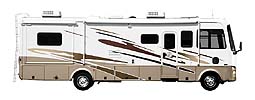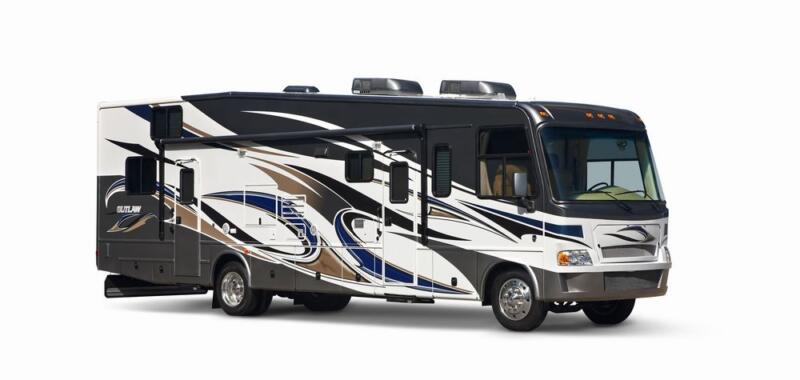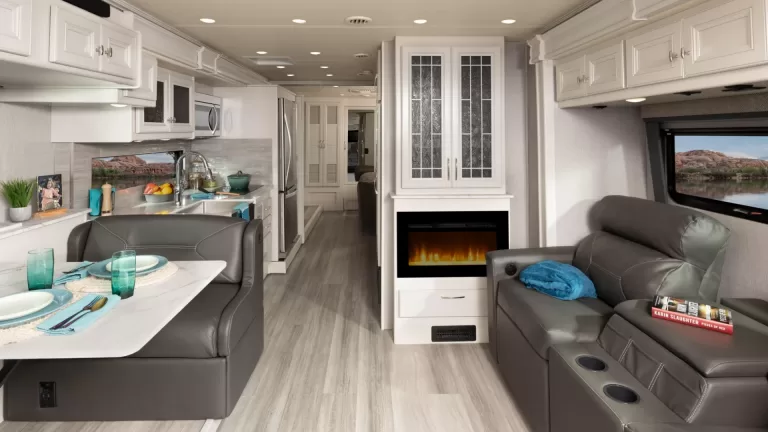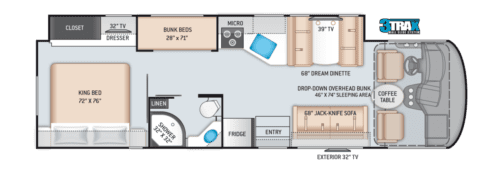This is a brief introduction to the Class A Motorhome type of RV, intended to provide essential information for choosing the best RV type. (Looking for Class A Manufacturers?)
Not sure if this is the right RV type for you? Please take a look at our RV Types Pros & Cons Checklist.
What Is a Class A Motorhome?

Definition of a Class A RV
Class A motor home is a recreational vehicle (RV) built on a stripped truck chassis where the driving compartment is an integral part of the RV interior. Class A motor homes look like buses. It’s also commonly called a Class A coach.
Unlike towable RV campers like 5th wheels and travel trailers, you drive a Class A motorhome. And no, you don’t generally need a special license to drive one!
Lengths range from 24 to 50 feet, with 28 to 40 feet being the most common. Width ranges from 8 ft (standard) to 8.5 ft (wide-body).
Class A motorhomes are widely split into two/two subsets:
- Gas/diesel
- Pusher/puller
Puller coaches have front-mounted engines. Pusher coaches have rear-mounted engines.
As a rule, you’ll find gas-powered “puller” powertrains on smaller, entry-level Class A’s.
The crème de la crème is a “diesel pusher,” which typically provides better power, better handling, less cabin noise, and superior fuel efficiency.

Introduction to the Class A RV Model Type
Class A motorhomes are the luxury land yachts of the RV world. They are big, bold and unapologetic. You’ll be hard-pressed to find one that costs less than six figures. Custom creations can even cost seven figures (that’s more than a million dollars, people!)
You can find anything inside a Class A. Want a washer and dryer? Check. A walk-in closet? Why not?! A reclining sofa with lighted cup holders? Your wish is their command.
These motorhomes – also called coaches – look like giant touring buses. They are built on heavy-duty chassis sourced from major OEM manufacturers. Big names include:
- DynoMax
- Ford
- Freightliner
- Roadmaster
- Spartan
And perhaps that’s the first thing you should know about Class A coaches. The RV manufacturer doesn’t build the chassis or powertrain (thank God). Think of the RV manufacturer more as the final assembler.
Unlike the semi truck motor home, the chassis of a Class A does not come from the factory with a driving compartment (or cab). The chassis includes the following major components: frame, engine, fuel tank, axles, drive train, wheels, tires, steering column, engine and braking controls, and dashboard instruments.
Who Might Want a Class A RV?
Obviously, “camping” in a Class A motorhome is far cry from the A-frame tents and MREs of Boy Scout backpackers! Traveling in a Class A is like the First Class of RVing. You’ll want for nothing – but you’ll pay for it.
BUT …
(and this is a big but)
… the big footprint comes with a cost. They don’t work for everyone.
You are somewhat limited in where you can go. Overhanging trees, low bridges, hairpin turns, steep inclines and parking spaces will thwart and defy your every move.
No more drive-in meals. No more downtown parking lots. No more “I wander what’s down that street?”
That’s why many RVers, especially full-timers, tow an additional vehicle behind their motorhome. Only now you’re piloting your own caravan!
In short, Class A RVs are good for “basecamp” style travel. You drive somewhere, set up camp, and explore the local area with your “toad” vehicle. If you plan to get up and go every morning, something smaller, like a Class C, would be a better fit.
Class A Motorhome Pros and Cons
PROS
- Easy to drive on major highways and Interstates.
- Spacious, open floor plans suitable for large families and full-timers.
- Elevated driver position provides a good view of the road ahead.
- Driving and living compartments are connected. No need to get out of the RV during stops. Living area accessible even while moving.
- Most cargo storage space of all RV types.
- Self-contained facilities (propane, water) make for easy dry camping.
- Does not need to be deployed to be used or accessed.
- Can tow vehicle behind or support a carrying platform on hitch receiver.
- Residential-style layout and furnishings.
CONS
- Most expensive of all RV types.
- The RV Consumer Group rates Class A’s as having more structural problems and safety issues in crashes.
- Larger models can be difficult to maneuver in tight spaces.
- Driving compartment being part of the living space does not appeal to some people, feeling like they are always in a vehicle.
- Most are too large to drive around town; alternate local transportation required.
- Elevated driver position and width of the vehicle make it difficult to judge clearance on the right side.
- Top clearance can be a problem under low branches and structures.
- Problem compounded if carrying items on roof, such as canoes.
- Requires large storage area when not in use.
- Poor fuel efficiency. Figure 6-10 mpg for gas models, 8-14 mpg for diesel.

Key Features in a Class A Motorhome
The most obvious appeal of a Class A motorhome is the unparalleled luxury. Living inside a full-size coach is very similar to dwelling in a luxury apartment suite or a single-family house.
However, there’s more to the story. Just because Class A’s look like a luxury apartment doesn’t mean they’re built like on.
Size and Space
If you believe bigger is better, you’ll love a Class A motorhome. These luxury coaches typically range from 24 to 50 feet (most are 28-45 feet).
Class A motorhomes also commonly come with slide-out rooms, allowing you to double the amount of livable space once you set up for camp. The slide-outs tend to be somewhat shallower than, say, a 5th wheel, since it’s important to evenly distribute weight side-to-side.

2022 Thor A.C.E. 32.3 Floorplan
Consider this A.C.E. gas-powered motorhome from Thor Motor Coach. It has one full-wall slide-out. It can comfortably accommodate 6-8 people, and it can be used even without the slide-outs extended.

2022 Thor Venetian B42 Floorplan
This floorplan is from a much larger 42-foot motorhome, also from Thor, with a rear-mounted diesel engine. It has three huge slide-outs and significantly more living space.
Almost all motorhomes have large “basements,” which are cargo areas in the chassis underneath the main floor. These are where the mechanical innards of the RV are stored. They are also commonly used as accessible storage bays for cargo.
Residential Features
Smaller RVs are forced to make the most of every square inch. In a Class A motorhome, space is a luxury. It’s larger than most New York apartments, for Pete’s sake!
So you might see residential-style features like:
- Full bathrooms (with standup showers)
- Full kitchens with residential-sized refrigerators and dishwashers
- Multiple televisions
- Kitchen islands
- Residential-style coil spring or pillowtop mattresses
Only you can decide if these features are necessary for you.
By the way, don’t confuse the term “residential-style” with “residential-quality.” The uncomfortable truth is that many $150,000 Class A motorhomes are built with similar or identical components as $30,000 travel trailers.
(Psst. I dive deeper into this idea in this construction quality report from AskTheRVEngineer.)
Class A Motorhome Sub-Types
The Class A motor home has one sub-type:
Bus Conversion
The name gives it away—a bus conversion is a commercial passenger bus that has been converted into an RV. Some bus conversions are easy to spot because their previous skin is mostly intact. Often these look like a Greyhound bus. Some bus conversions undergo major remodeling inside and out, and are more difficult to see their origin. One of the most used platforms for luxury conversions is the Prevost bus.
Though not sub-types, people often refer to some Class A’s as a pusher or diesel pusher. A pusher is a motor home with rear mounted engine for the purposes of better accommodating large engines. Two other benefits of having the engine in the rear is the reduced engine noise and the ability to install the main door near the front of the vehicle.
Class A Motorhome Major Manufacturers
There are about 20 major Class A motorhome RV manufacturers in North America.
Some of the biggest names include:
- Thor
- Winnebago
- Entegra
- Forest River Berkshire
- Tiffin
- Newmar
- Jayco
For a full list of manufacturers, check out our comprehensive RV manufacturer’s list!
There are also dozens of custom coachbuilders who will design you a bespoke Class A motorhome, complete with cat towers, double queen beds, flat screen TVs on the ceiling, or whatever else your heart desires. They are not shown on our lists.
We’ve spotlighted a few brands below. These brands are either known for their popularity, quality, or innovation.
Thor Motor Coach

Thor is Big Dog. The company manufactures 11 lines of Class A motorhomes, including the luxurious Palazzo and the popular Challenger series.
Everyone 1 out of 4 motorhomes sold in America is a Thor. You’ll find no shortage of configurations, lengths, floorplans, features and styles.
Coachman

Coachmen is an RV manufacturer based in the state of Indiana and has been in operation since 1964. The company is owned by Berkshire Hathaway.
One of the monster RV brands, Coachman builds just about everything. Quality runs the gamut from excellent to mediocre.
The company is most well-known for its conventional trailers and roomy floorplans.
REV Group
REV Group owns, among other brands, Fleetwood, American Coach, Monaco Coach, Holiday Rambler and Renegade RV.
All these brands manufacture Class A motorhomes ranging from entry-level to six-figure land yachts. REV Group is known for producing better-quality units than mainstream Thor and Forest River coaches.
Newmar Motorhomes
Newmar is an RV manufacturer based in the state of Indiana and has been in operation since 1968. The company is owned by Winnebago Industries.
Like other Winnebago brands, Newmar is known for consistent construction quality and fine interior design. They build diesel- and gas-powered Class A and Super C motorhomes.
Tiffin Motorhomes

Tiffin Motorhomes is an RV manufacturer based in the state of Alabama and has been in operation since 1972. The company is owned by Thor Industries.
Tiffin Motorhomes is arguably the preeminent manufacturer of luxury motorhomes in America, focusing on their diesel-powered Class A lineup.
Winnebago
![]()
Winnebago is an RV manufacturer based in the state of Iowa and has been in operation since 1958. The company is owned by Winnebago Industries.
An iconic RV brand, Winnebago builds almost every size of RV available! They are known for their high quality, reasonable prices and long-lasting value.
Class A Motorhome FAQs
Ehh … no.
Class A motorhomes are good for “dry camping” or “Wallydocking,” the art of self-contained camping without hookups. Thanks to their big propane, water and waste tanks, they can run off-grid for some time. And in a pinch, you can always fire up the engine to get power!
But they’re not good for true primitive camping or boondocking, which usually involves tight spaces and high-clearance roads.
Plus, appliances on Class A motorhomes are power-hungry. You’ll need a hefty generator to run your RV for 48-72 hours off-grid with full use of appliances.
Yes! In fact, many full-timers swear by this.
The second vehicle is called “toad.” Most vehicles require a tow dolly so only the rear wheels spin freely on the road. A few vehicles, such as Jeeps, can be flat-towed with all four wheels rolling on the ground.
However, be aware that you can’t fill a Class A RV full of cargo and still expect it to be able to tow a vehicle. You’ll need to balance the capacities.
Related RV Checklists
The following RV checklists on our web site are applicable to Class A motor homes:








